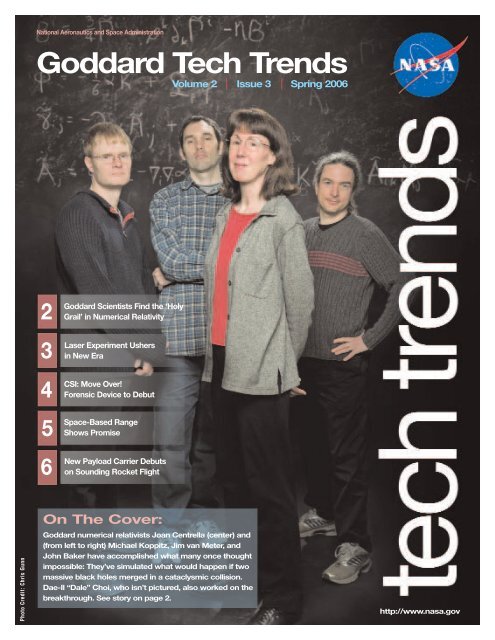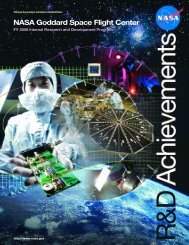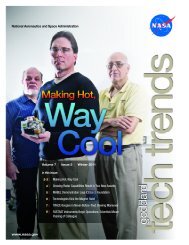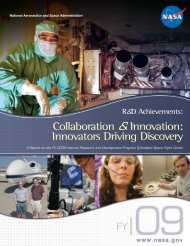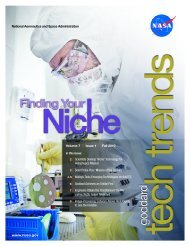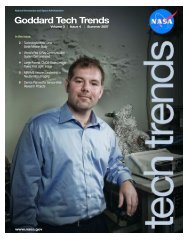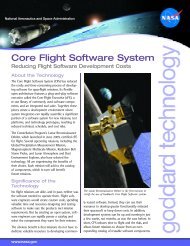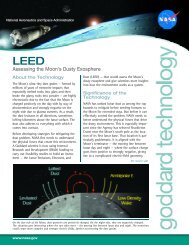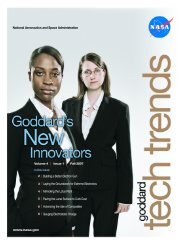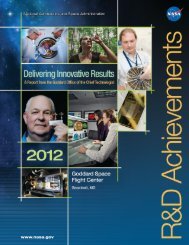Goddard Tech Trends - NASA's Goddard Technology Management ...
Goddard Tech Trends - NASA's Goddard Technology Management ...
Goddard Tech Trends - NASA's Goddard Technology Management ...
Create successful ePaper yourself
Turn your PDF publications into a flip-book with our unique Google optimized e-Paper software.
National Aeronautics and Space Administration<br />
<strong>Goddard</strong> <strong>Tech</strong> <strong>Trends</strong><br />
Volume 2 Issue 3 Spring 2006<br />
2<br />
3<br />
4<br />
5<br />
6<br />
<strong>Goddard</strong> Scientists Find the ‘Holy<br />
Grail’ in Numerical Relativity<br />
Laser Experiment Ushers<br />
in New Era<br />
CSI: Move Over!<br />
Forensic Device to Debut<br />
Space-Based Range<br />
Shows Promise<br />
New Payload Carrier Debuts<br />
on Sounding Rocket Flight<br />
Photo Credit: Chris Gunn<br />
On The Cover:<br />
<strong>Goddard</strong> numerical relativists Joan Centrella (center) and<br />
(from left to right) Michael Koppitz, Jim van Meter, and<br />
John Baker have accomplished what many once thought<br />
impossible: They’ve simulated what would happen if two<br />
massive black holes merged in a cataclysmic collision.<br />
Dae-Il “Dale” Choi, who isn’t pictured, also worked on the<br />
breakthrough. See story on page 2.<br />
http://www.nasa.gov
02<br />
Finding the Holy Grail<br />
<strong>Goddard</strong> Scientists Discover What Happens When Black Holes Merge<br />
<strong>Goddard</strong> <strong>Tech</strong> <strong>Trends</strong><br />
A team of <strong>Goddard</strong> scientists has found the “holy grail”<br />
of numerical relativity by simulating what happens<br />
when two massive black holes merge in a cataclysmic<br />
collision, which scientists describe as second only to<br />
the Big Bang as one of nature’s most powerful and<br />
energetic events.<br />
Using sophisticated numerical codes, the team has calculated<br />
the shape of the resulting gravitational waves<br />
that would radiate in all directions, much like the<br />
ripples that happen when a stone is thrown into a<br />
pond. Although Einstein predicted the existence of<br />
gravitational waves in his Theory of General Relativity,<br />
no one has directly detected them yet. And until now,<br />
no one has calculated what these waves might look<br />
like in a science called numerical relativity, said Joan<br />
Centrella, Chief of the Gravitational Astrophysics<br />
Laboratory and principal investigator on the study.<br />
Now that Centrella and her team have demonstrated<br />
the waveforms, scientists have the means to test<br />
Einstein’s theories under extreme gravitational fields.<br />
This will benefit NASA’s proposed Laser Interferometer<br />
Space Antenna (LISA), a gravitational wave detector<br />
that the Agency hopes to fly the next decade (see story<br />
on page 8). Rather than simply inferring the existence<br />
of gravitational waves due to the motion of celestial<br />
bodies, LISA will use advanced laser interferometry to<br />
directly detect and measure them.<br />
Fundamentally New Knowledge<br />
“Our results will allow LISA to carry out tests of<br />
Einstein’s general relativity in a regime that’s never<br />
been accessible before,” Centrella said. “The waveforms<br />
we have produced give us the first look at what<br />
happens when black holes merge. This will give us<br />
fundamentally new knowledge about one of the most<br />
amazing theories ever conceived by the human mind.”<br />
Although Einstein proposed his theories 90 years ago,<br />
no one has ever solved the underlying equations with<br />
paper and pen due to their great complexity. “The only<br />
way to solve these equations is on a computer using<br />
the methods of numerical relativity, but this has proven<br />
difficult. In fact, a few years ago, some even said that<br />
numerical relativity was impossible because the computer<br />
codes were unstable. They crashed well before<br />
the black holes completed even a fraction of an orbit,”<br />
said Centrella, who used Internal Research and<br />
Development funding to begin the work at <strong>Goddard</strong>.<br />
More Work Remains<br />
Although her team’s work represents a major breakthrough,<br />
she concedes that more work still needs to<br />
be done. Relying now on <strong>Goddard</strong>’s Core Capabilities<br />
funding, a Beyond Einstein Foundation Science grant<br />
from NASA Headquarters, and the LISA project, she<br />
and her team are focusing on even more complex cal-<br />
Continued, Page 8<br />
This image shows the two massive black holes just before they<br />
merge. It was based on calculations performed by <strong>Goddard</strong><br />
numerical relativist Joan Centrella and her team.<br />
Using sophisticated computer codes, <strong>Goddard</strong>’s numerical relativists<br />
calculated the gravitational waves that would radiate out<br />
in all directions when two massive black holes merged.<br />
Illustration: Chris Henze, Ames Research Center<br />
http://gsfctechnology.gsfc.nasa.gov Volume 2 Issue 3 Spring 2006
Historic Test Brings Laser Spacecraft Ranging to a New Era<br />
<strong>Tech</strong>nology Slated for Use on the Lunar Reconnaissance Orbiter<br />
03<br />
An experiment in which an Earth-based observatory successfully<br />
exchanged laser pulses with the MESSENGER<br />
spacecraft while the two were millions of miles apart has<br />
helped to convince mission planners to include the same<br />
technology on the Lunar Reconnaissance Orbiter (LRO),<br />
which will launch in 2008 to map the lunar surface.<br />
The hope is that the highly precise laser-ranging technology<br />
demonstrated last spring with MESSENGER’s<br />
Mercury Laser Altimeter (MLA) will allow scientists to<br />
measure with centimeter accuracy the disturbances to<br />
LRO’s orbit around the Moon. With that information,<br />
they hope to learn more about the Moon’s well-known<br />
gravitational anomalies, which NASA first measured during<br />
the early days of the space program.<br />
“We proposed a subsystem for the Lunar Reconnaissance<br />
Orbiter and this experiment was the proof that it would<br />
work,” said Xiaoli Sun, MLA Instrument Scientist, referring<br />
to the record-breaking test that he and other MLA<br />
team members conducted from the <strong>Goddard</strong><br />
Geophysical and Astronomical Observatory in late May.<br />
“Our test with MESSENGER helped to convince us that<br />
we could do this with LRO.”<br />
Historic First<br />
The test between MESSENGER, which stands for<br />
MErcury Surface, Space ENvironment, GEochemistry<br />
and Ranging, and the <strong>Goddard</strong> observatory made headlines<br />
because it represented the first time scientists were<br />
able to conduct a two-way exchange of laser signals over<br />
vast distances in space. At the time, MESSENGER was 15<br />
million miles from Earth on its 6.6-year journey to<br />
Mercury, where it will map the planet’s surface.<br />
In addition to proving that such an exchange could<br />
occur at interplanetary distances, the test demonstrated<br />
its sub-nanosecond timing accuracy. It also calibrated the<br />
laser pointing and receiver bore sight, which was the<br />
principal reason for the test, Sun said.<br />
Long Time Coming<br />
NASA has long wanted to demonstrate the laser-ranging<br />
capability across deep space because of its widespread<br />
potential. In addition to determining orbital positioning<br />
needed for fundamental geophysical studies, the same<br />
laser technology can dramatically improve<br />
Continued, Page 6<br />
<strong>Goddard</strong> <strong>Tech</strong> <strong>Trends</strong><br />
<strong>Goddard</strong> technologists used this 1.2-meter Telescope Tracking Facility at the <strong>Goddard</strong> Geophysical and Astronomical<br />
Observatory to fire laser pulses to MESSENGER.<br />
Inset: A crane lifted MESSENGER out of the thermal vacuum chamber at the <strong>Goddard</strong> Space Flight Center after it completed<br />
5 weeks of rigorous tests to show that it could withstand the wide range of hot and cold temperatures that it would<br />
encounter on its journey to and mission around Mercury.<br />
Volume 2 Issue 3 Spring 2006<br />
http://gsfctechnology.gsfc.nasa.gov
04<br />
CSI: Move Over!<br />
<strong>Goddard</strong>-Developed Portable Forensic Analyzer Nears Completion<br />
<strong>Goddard</strong> <strong>Tech</strong> <strong>Trends</strong><br />
After 6 years in development, the<br />
portable forensic analyzer that<br />
<strong>Goddard</strong> scientists are developing<br />
with experts in academia, law<br />
enforcement, and criminal justice<br />
is expected to soon make its<br />
debut at a simulated crime scene<br />
to test whether the device can<br />
detect the presence of blood,<br />
gunshot residue, and other<br />
materials.<br />
Principal Investigator Jacob<br />
“Jack” Trombka, who began<br />
thinking of ways to apply NASA<br />
exploration technology to forensic<br />
science more than 30 years<br />
ago, has created a breadboard<br />
model of a portable X-ray fluorescence<br />
(XRF) system that’s<br />
similar in concept to those<br />
under development for planetary<br />
exploration.<br />
Equipped with silicon and cadmium-zinc<br />
telluride detectors, the system works by firing<br />
X-rays at an object. Atoms on the object’s surface<br />
then emit lower-energy fluorescent X-rays that are then<br />
detected and analyzed to determine their elemental<br />
composition. For instance, certain bodily fluids typically<br />
contain high concentrations of zinc, iron, and calcium,<br />
while gunpowder contains barium, antimony, and<br />
strontium.<br />
Telltale Signature<br />
The presence of these elements creates a telltale signature<br />
that investigators would recognize as potentially<br />
suspicious. That way, crime scene investigators would<br />
know immediately whether to collect the sample for<br />
further analysis or to leave it behind, Trombka said. The<br />
beauty of XRF, he added, is that the technology doesn’t<br />
destroy the sample it irradiates.<br />
The first demonstration is expected to take place in<br />
April at a special simulated crime scene to be set up at<br />
<strong>Goddard</strong>. Trombka said he plans to hold public demonstrations<br />
later.<br />
The project, which first began in 1998 under a<br />
Memorandum of Understanding with the Department<br />
of Justice, involves investigators from three universities,<br />
three state forensic laboratories, one district attorney’s<br />
office, and <strong>Goddard</strong>. However, discussions about developing<br />
such a device began 30 years ago when a good<br />
friend of Trombka’s — Sam Dash, the former chief<br />
<strong>Goddard</strong> Principal Investigator Jack Trombka (right) and two of his <strong>Goddard</strong> colleagues,<br />
Eric Young (left) and Sam Floyd (center), work on the portable forensic analyzer that<br />
will soon make its debut at a simulated crime scene.<br />
Watergate counselor — talked with him about using<br />
NASA know-how to advance the technology.<br />
Dash’s idea seemed like a good one, Trombka said.<br />
Both the forensic community and NASA’s planetaryexploration<br />
program would benefit from an analyzer,<br />
Trombka said. Now in its final stages of development,<br />
Trombka said the device is almost ready for commercialization<br />
and discussions have begun with potential<br />
manufacturers.<br />
“This Has Been Fun”<br />
One of the project’s challenges, he said, was developing<br />
a system that manufacturers could sell at relatively<br />
inexpensive prices. “Another question we had to consider<br />
was how to design a system so that it could be calibrated<br />
or even repaired remotely,” Trombka said. “We<br />
tried to keep much of it digital so that problems could<br />
be isolated and repairs could be made in software —<br />
not hardware.”<br />
That’s where NASA’s experience helped, he said.<br />
Satellite instruments are built to be remotely calibrated.<br />
“I have to be honest,” Trombka said, referring to his 6<br />
years on the project. “This has been fun.” ◆<br />
Contact:<br />
Jacob.I.Trombka@nasa.gov or 301.286.5941<br />
http://gsfctechnology.gsfc.nasa.gov Volume 2 Issue 3 Spring 2006
Experiment Proves Feasibility of a Space-Based Range<br />
Development Could Reduce Flight Costs<br />
05<br />
A recent technology demonstration carried out on a twostage<br />
Terrier Improved Orion sounding rocket late last<br />
year has the potential to revolutionize the way that<br />
range-safety officers monitor and abort rockets as they<br />
make their ascent into the heavens, say technologists<br />
involved in the test.<br />
In late December, technologists flew the Space-Based<br />
Telemetry and Range Safety (STARS) experiment and<br />
successfully showed that NASA could use its Tracking and<br />
Data Relay Satellites (TDRS) to provide vehicleposition<br />
tracking data during ascent and over-thehorizon<br />
flight operations. It also proved that NASA could<br />
use the TDRS network to transmit flight-abort commands<br />
as the rocket made its way along its flight path.<br />
"...the purpose of this demonstration was to<br />
show the viability of using a<br />
space-based tracking system and bypassing<br />
the ground systems all together.”<br />
“Traditionally, range-safety officials have used radar from<br />
ground stations to track flight vehicles and ground-based<br />
command systems to abort a rocket’s flight should it<br />
veer off course.” said Steven Bundick, a project manager<br />
at the Wallops Flight Facility. “However, it’s become<br />
increasingly more expensive to staff and maintain these<br />
aging facilities and the purpose of this demonstration<br />
was to show the viability of using a space-based tracking<br />
system and bypassing the ground systems all together.”<br />
<strong>Goddard</strong> <strong>Tech</strong> <strong>Trends</strong><br />
In addition to reducing ground operation costs, the<br />
advent of a space-based range would require less communication<br />
and shorten launch-turnaround times, NASA<br />
officials say. A space range also would allow the Agency<br />
to launch multiple vehicles in a short period of time<br />
from any U.S. spaceport.<br />
Jointly developed by the Kennedy Space Center and the<br />
<strong>Goddard</strong> Space Flight Center’s Greenbelt and Wallops<br />
campuses, STARS was one of two experiments included<br />
in the maiden flight of Wallops’s new payload carrier, the<br />
Suborbital <strong>Tech</strong>nology Experiment Carrier. The payload<br />
carrier will be made available twice a year or as required<br />
(see related story on page 6).<br />
“This technology is an example of how Wallops continues<br />
to reduce costs and improve performance,”<br />
Bundick said. More tests of the range-safey system are<br />
planned. ◆<br />
Contact:<br />
Steven.N.Bundick@nasa.gov or 757.824.1424<br />
The two-stage Terrier Improved Orion rocket lifted off from<br />
the Wallops Flight Facility in late December carrying a new<br />
payload carrier and an experiment that demonstrated the<br />
viability of a space-based range.<br />
Volume 2 Issue 3 Spring 2006<br />
http://gsfctechnology.gsfc.nasa.gov
06<br />
<strong>Goddard</strong> <strong>Tech</strong> <strong>Trends</strong><br />
New Payload Carrier Debuts on Sounding Rocket Flight<br />
<strong>Tech</strong>nologists at the Wallops Flight<br />
Facility have developed a new sounding<br />
rocket payload carrier that they believe<br />
will help mature emerging technologies<br />
more rapidly because it offers researchers<br />
a chance to test their experiments in<br />
space at a fraction of the typical cost.<br />
Tested late last year aboard a two-stage<br />
Terrier Improved Orion rocket, the<br />
Suborbital <strong>Tech</strong>nology Experiment<br />
Carrier (Sub-TEC) payload consisted of<br />
two experiment sections and a suite of<br />
support instrumentation, including<br />
power, timing, telemetry, attitude sensors,<br />
and system components needed<br />
to recover payloads.<br />
“If you have an experiment that requires a flight test in<br />
the space environment and it will physically fit in one of<br />
the two experiment canisters, we can fly it for you at a<br />
fraction of the cost of a custom-designed payload on an<br />
orbital mission,” said John Hickman, who is responsible<br />
for technology development for NASA’s Sounding<br />
Rocket Program Office at Wallops.<br />
“We can do this by providing a standardized set of support<br />
systems, sealing them in specially designed modules,<br />
and reusing the hardware once it is recovered and<br />
refurbished,” he added. “Basically, we already have built<br />
80 percent of the payload and have it sitting on the<br />
shelf. As a result, we can fly experiment modules for<br />
Following the maiden flight of the new Suborbital <strong>Tech</strong>nology Experiment<br />
Carrier (Sub-TEC), engineers and technicians disassembled and inspected the<br />
payload’s telemetry system after Sub-TEC was recovered from the water.<br />
Everything was dry.<br />
NASA customers for about $3,000 to $5,000 per pound,<br />
depending on the complexity of the experiment.”<br />
During its maiden flight, Sub-TEC carried the Spacebased<br />
Telemetry and Range Safety (STARS) experiment<br />
(see related story on page 5) — a joint effort involving<br />
the Kennedy Space Center and <strong>Goddard</strong> — and several<br />
in-house new technology experiments for the sounding<br />
rocket program. ◆<br />
Contact:<br />
John.C.Hickman@nasa.gov or 757.824.2374<br />
Laser Spacecraft... Continued from page 3<br />
communications in deep space. The Mars Telecommunications<br />
Orbiter, which NASA cancelled last summer<br />
due to budget constraints, would have used lasers to<br />
transmit data between Earth and Mars at a rate of 1 to 30<br />
million bits per second, depending on how close the two<br />
planets were. Currently, the maximum data speed with<br />
microwave technology is about 100,000 bits per second.<br />
In addition, scientists can use laser-ranging techniques to<br />
track spacecraft in solar orbit. From these studies, they<br />
can study the Sun’s gravity and infer the internal structures<br />
of the planets.<br />
Until last spring, however, a successful demonstration<br />
eluded scientists. In 1992, laser pulses were successfully<br />
transmitted and detected by the camera onboard the<br />
Galileo probe while it was 4 million miles away.<br />
However, Galileo carried neither a laser transmitter nor a<br />
timing capability. <strong>Goddard</strong> scientists also attempted similar<br />
tests with the Mars Orbiter Laser Altimeter onboard<br />
the Mars Global Surveyor and the Laser Ranger on the<br />
Near Earth Asteroid Rendezvous mission, but bad<br />
weather and spacecraft scheduling problems shut down<br />
the experiments.<br />
Lunar Subsystems<br />
Since the successful demonstration, LRO mission planners<br />
have decided to install a small optical receiver that will<br />
receive laser pulses from ground stations on Earth. The<br />
time that it takes the laser pulses to travel from the<br />
ground station to LRO determines with centimeter precision<br />
the orbiter’s position. In comparison, conventional<br />
radio-frequency tracking techniques only can measure<br />
spacecraft position to several meters, Sun said.<br />
Knowing highly precise positional data can reveal much<br />
about the effect of lunar gravity on the spacecraft’s orbit.<br />
“Such studies are crucial for improving our ability to predict<br />
the spacecraft position,” Sun said. “That way we<br />
assure safer landings for human and robotic cargo in<br />
future exploration.” ◆<br />
Contact:<br />
Xiaoli.Sun-1@nasa.gov or 301.614.6732<br />
http://gsfctechnology.gsfc.nasa.gov Volume 2 Issue 3 Spring 2006
New High-Gain Antenna Speeds Up Data Delivery for Ballooncraft<br />
<strong>Tech</strong>nology Demonstrated on CREAM<br />
07<br />
Researchers who use balloons to carry their experiments<br />
to the upper-most reaches of Earth’s atmosphere now<br />
have the means to retrieve their data at greatly increased<br />
rates in near real-time — in sharp contrast to what was<br />
available to them before.<br />
The Wallops Flight Facility has developed a new highgain<br />
antenna that uses the Agency’s Tracking and Data<br />
Relay Satellite (TDRS) system to transmit scientific and<br />
housekeeping data in real-time at 100 kilobits per second.<br />
This represents a more than 10-fold increase over<br />
data rates previously achieved using omni-directional<br />
antennas.<br />
The 18-inch flat plate array antenna already has flown on<br />
the two Cosmic Ray Energetics and Mass (CREAM) payloads<br />
launched from McMurdo Station in Antarctica. The<br />
experiment, a joint effort involving several U.S. and foreign<br />
universities, measures the spectra of cosmic-ray<br />
nuclei from helium to iron. The most recent mission<br />
ended Jan. 15 after the balloon spent 28 days aloft.<br />
“The researchers got their data immediately and we<br />
were able to monitor our systems continuously and<br />
respond immediately” said Wallops Project Manager<br />
Linda Thompson, referring to the speed by which<br />
researchers received their data during CREAM 2. At 100<br />
kilobits per second, she likened the situation to what<br />
people experience when they migrate from dial-up to<br />
broadband.<br />
During the CREAM launch, data was transmitted to<br />
TDRS, which then sent it to White Sands, N.M. From<br />
there, it went to the Operations Control Center in<br />
Palestine, Texas, the Engineering Support Center at<br />
Wallops Island, Va., and on to the Science Operations<br />
Center at the University of Maryland in College Park.<br />
The antenna has a bright future, Thompson said. “It definitely<br />
could be used on aircraft.” Future enhancements<br />
will increase its data rate to upwards of 1200 kilobits per<br />
second. ◆<br />
Contact:<br />
Linda.D.Thompson@nasa.gov or 757.824.1072<br />
Brian.A.Corbin@nasa.gov or 757.824.1012<br />
<strong>Goddard</strong> <strong>Tech</strong> <strong>Trends</strong><br />
The high-gain antenna has flown on two Cosmic Ray Energetics and Mass (CREAM) payloads launched from McMurdo<br />
Station in Antarctica. The most recent mission ended Jan. 15.<br />
Volume 2 Issue 3 Spring 2006<br />
http://gsfctechnology.gsfc.nasa.gov
08<br />
<strong>Goddard</strong> <strong>Tech</strong> <strong>Trends</strong><br />
Black Holes... Continued from page 2<br />
culations related to black-hole mergers. Originally, her<br />
calculations focused on black holes with equal masses<br />
and no spin. However, in nature black holes do spin,<br />
and binary black holes are likely to have non-equal masses.<br />
“So, there is some real work yet to do,” she said. “But<br />
our recent work opens the way for this to happen.”<br />
Revealing Mass and Motion<br />
Much can be learned from gravitational waves, which<br />
occur when massive celestial objects move and disrupt the<br />
fabric of spacetime that surround them, Centrella said.<br />
Similar to visible light in that they both travel in waves,<br />
spreading outward from their sources, gravitational<br />
waves carry information about the mass and motion of<br />
the objects that created them. “In particular, the gravitational<br />
waveform provides a map of what the black holes<br />
are doing when they move through spacetime,” she<br />
added. “Even though we can’t see the black holes,<br />
which are deep inside the centers of galaxies, we can<br />
map their motions by observing their gravitational waveforms.”<br />
Much of what scientists know about gravity comes from<br />
experiments within the solar system, where the gravitational<br />
fields are relatively weak. These experiments confirmed<br />
Einstein’s basic premise that gravity is a universal<br />
force connecting all forms of mass and energy. This<br />
means that gravity should act the same throughout the<br />
universe; however, important questions remain unanswered<br />
— particularly in the area of how gravity behaves<br />
under extreme conditions, such as when black holes merge.<br />
Centrella and her team recently submitted their findings<br />
for publication in The Physical Review, a scientific<br />
journal. ◆<br />
Contact:<br />
LISA: Opening a New Window on the Universe<br />
NASA’s proposed Laser Interferometer Space Antenna<br />
(LISA) consists of three, pillbox-shaped spacecraft that<br />
will be placed more than 3 million miles apart in a triangle-shaped<br />
configuration to search for gravitational<br />
waves with 100 times greater precision than anything<br />
achieved before.<br />
Joan.Centrella@nasa.gov or 301.286.3966<br />
Expected to fly next decade, LISA will measure gravitational<br />
waves radiating out from binary-star systems,<br />
black holes in our galaxy, and mergers of massive black<br />
holes where distant galaxies have collided. Mission<br />
planners also hope to be able to detect gravitational<br />
waves generated by the Big Bang, the cataclysmic<br />
event that created the universe. ◆<br />
<strong>Goddard</strong> <strong>Tech</strong> <strong>Trends</strong><br />
<strong>Goddard</strong> <strong>Tech</strong> Tends is published quarterly by the <strong>Goddard</strong> <strong>Tech</strong>nology <strong>Management</strong> Office (Code 502) at the<br />
<strong>Goddard</strong> Space Flight Center in Greenbelt, Md. The newsletter describes technology developments at the<br />
Center and explains how they are helping NASA to achieve its missions. If you want more information about<br />
<strong>Goddard</strong> technology or the <strong>Goddard</strong> <strong>Tech</strong>nology <strong>Management</strong> Office, contact the Code 502 representatives<br />
below. If you wish to be placed on the newsletter distribution list, contact the editor.<br />
Peter M. Hughes<br />
Chief <strong>Tech</strong>nologist<br />
Code 502<br />
301.286.2342<br />
Peter.M.Hughes@nasa.gov<br />
Lisa W. Callahan<br />
Deputy Chief <strong>Tech</strong>nologist<br />
Code 502<br />
301.286.1212<br />
Lisa.W.Callahan@nasa.gov<br />
Lori J. Keesey<br />
Editor<br />
301.258.0192<br />
ljkeesey@comcast.net<br />
np-2006-2-752-GSFC<br />
http://gsfctechnology.gsfc.nasa.gov Volume 2 Issue 3 Spring 2006


